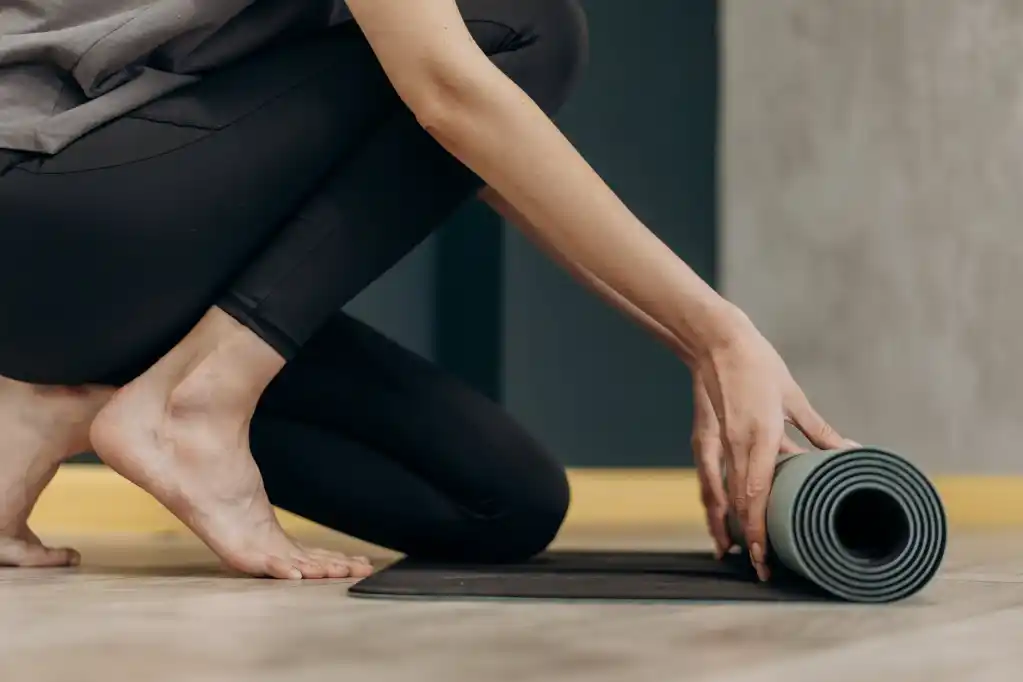Core exercises provide the basis for optimal body movement, therefore building a strong core is an important part of training. The link between our lower and upper extremities is provided by our core, which binds the body together. The core is the driving force and the foundation of support for the entire body, and it generates all motions. A strong, flexible core will help you avoid injuries, improve sports performance, and correct postural problems, as well as help you pop your abs.
You might be surprised with the best core workouts. It’s not enough to simply perform sit-ups and ab crunches. You must train a range of muscles, from your hips to your shoulders, to develop a strong core.
The majority of people associates the core with a six-pack or toned abs. The abs, on the other hand, have a very restricted and specialized activity, and the “core,” as professionals refer to it, is essentially a collection of muscles that run the length of the torso.
When these muscles engage, they stabilize the spine, pelvis, and shoulder girdle, providing a strong foundation for forceful extremity motions. To be effective, core conditioning workout regimens must target all of these muscle groups.
Let’s understand it more deeply.
What are the Muscles of the Core: Core Exercises ?
Your core muscles go from the top of your head to the bottom of your pelvis, and they include muscles like:
- The transverse abdominis is a muscle that wraps over the front and sides of your abdomen. The pelvis is stabilized by this muscle.
- Internal and external obliques: these muscles travel diagonally from the ribs to the pelvis, allowing you to rotate your trunk.
- Rectus abdominis, sometimes known as the ‘six-pack’ muscle, is a muscle in the abdomen. This is what you’re doing when you lean forward.
- Multifidus is a back muscle that helps to maintain the spine.
- Erector spinae: a back muscle that helps you stand up straight by extending your trunk.
Other than this your core also includes the following muscles such as the pelvic floor, diaphragm, glutes (hamstrings, hip flexors, and hip adductors) are muscles that link to the pelvis. Keeping these muscles strong helps balance your body, support your spine, and improve your overall fitness.
Why Core Exercises are important?
Your Posture Will Improve With A Strong Core
Core training might help you stand taller, according to a research published in Isokinetics and Exercise Science. Men who participated in three hour-long pilates sessions per week for two months experienced substantial gains in postural stability assessments, according to the research.
Enhance Athlete Performance
According to researchers at Ohio State University’s Wexner Medical Center, most people’s core muscles muscles aren’t nearly as powerful as they should be, and runners with weak deep core muscles are more likely to suffer low back pain. The low-back pain that runners experience is a result of poor form produced by a weak core, which has its own set of drawbacks.
Back Pain Reduction
The abdominals are credited with supporting the back and providing the basis for strength, yet they are only a tiny component of the core. In truth, low back pain is connected to weak and imbalanced core muscles.
WHICH MUSCLES CORE EXERCISES ARE EFFECTIVE?
The majority of people think of abs when they think about core muscles. The core, on the other hand, is made up of almost 12 separate muscles! They are made up of both deep and outer core muscles. When doing core workouts, you should expect to train the following muscles:
MUSCLES WITH A DEEP CORE
- Muscles of the pelvic floor (supports vital organs)
- Transverse abdominis is a muscle that runs across the middle of the abdomen (the muscles that help protect the spine)
- Obliques internes (muscles on the sides of the abdomen)
- Multifidus is a Latin word that means “many things (deep back muscles)
- Diaphragm is a muscle that connects the lungs and (primary respiration muscle).
MUSCLES IN THE EXTERIOR CORE
- Rectus abdominis is a muscle in the abdomen (six-pack abs muscles)
- Obliques on the outside (muscles on sides of the abdomen)
- Spinae Erector (lower back muscles)
- Lumborum quadratus (part of the abdominal wall)
- Gluteus maximus, hamstrings, and quadriceps are all hip muscles.
BEST CORE EXERCISES TO BOOST YOUR CORE
Now you have the relevant and essential information about muscle core, so it’s time to moving ahead with best core exercise that will strengthen your core.
Moves for beginners
Start with these introductory moves if you’re new to exercising or haven’t exercised in a long time.One good place to start is to inhale and visualise pushing your belly button nearer your spine as you do so. For a few seconds, keep your muscles stiff in that posture. When you engage — or tighten — your core, it feels like your stomach muscles are supported.
Crunch
Crunches are a tried-and-true core-strengthening exercise. Your abdominal muscles are worked when you elevate your upper body. If you experience periodic low back pain, go carefully and start with only a few reps when doing crunches. Before doing this classic crunch, consult a trained trainer or healthcare expert if your low back problem is chronic. It’s possible that it’s not the ideal solution for you.
- Begin by lying on your back. Bend your knees and place your feet hip-width apart on the floor. Make a straight line with your head and spine. Your arms should be crossed over your chest.
- Relax your neck and shoulders while tightening your core. Keep your lower back, pelvis, and feet on the floor by tucking in your chin and lifting your upper back. Pause.
- Return to the beginning posture by slowly lowering your upper back.
- Begin with a single set of 8–12 reps.
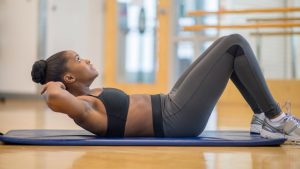
Bridge
This position engages your glutes to elevate your hips, training your buttocks and thighs while strengthening your core. Begin by lying on your back. Bend your knees and place your feet hip-width apart on the floor. Place your hands, palms down, at your sides.
- Tighten your glutes and core.
- Raise your hips until your knees and shoulders are in line.
- Hold the position for 10–30 seconds.
- Rep 3–5 times more.
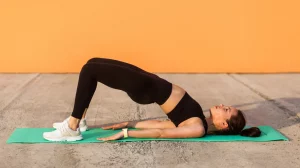
Bicycle crunch
This crunch variant targets your obliques, rectus abdominis, and hips. Begin on the floor with your back against the wall and your left leg bent and brought toward your chest. Maintain a small lift off the floor with your right leg. Place your hands behind your neck or on the bottom half of your head, being careful not to tug on your neck.
- Lift your right shoulder off the floor and bring your right elbow toward your left knee with your left knee bent and your right leg straight.
- Extend your left leg while bending and pulling your right knee toward your chest as you return your right shoulder to the floor.
- Lift your left shoulder off the floor and pull your left elbow toward your right knee while your right knee goes in more.
- Begin with three sets of 12 alternating reps.
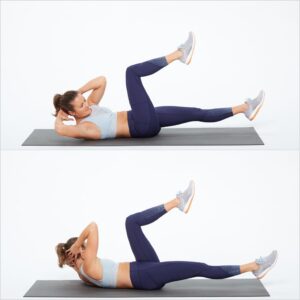
Intermediate-level movements
As you gain strength, progress to these intermediate workouts.
Plank
The plank is a core-targeting full-body workout. Arms, shoulders, back, glutes, and legs are all strengthened as well. Begin on your hands and knees, with your hands below your shoulders and knees below your hips.
- Keep your feet hip-width apart and straighten your legs behind you. Tighten you abdominal muscles.
- Hold the position for 10–30 seconds.
- Rep 3–5 times more.
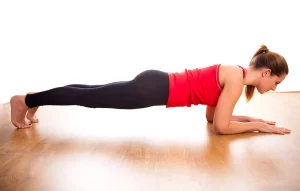
Warrior crunch
This crunch variant targets your core and lower body muscles, such as your thighs, glutes, and quadriceps.
- Stand with your toes turned outward and your feet somewhat wider than shoulder width. Close your eyes and open your chest with your hands behind your head.
- Tighten your glutes and core. Bring your thighs parallel to the floor by bending your knees.
- Bend your right elbow toward your right leg as you bend your body to the side. Rep on the other side.
- Begin with a single set of 8–12 repetitions.

For Advances moves
Challenge yourself to an advanced core workout once you’ve mastered intermediate techniques. By working your muscles in more complicated ways, these workouts will help you increase core strength.
Rotational side plank
This is a more difficult variant of the basic plank. Combining a side plank with arm motions improves your arms, shoulders, and obliques.
- Place your right forearm underneath your shoulder and lie on your right side. Extend your legs and place your left foot on top of your right. Tighten your abdominal muscles.
- To establish a straight line with your body, lift your hips. Raise your left arm straight over your head.
- Bring your left arm beneath your body and rotate your torso toward the floor.
- Return to the beginning position by rotating your body and straightening your left arm.
- Begin with a single set of 8–12 repetitions.
- Rep on the opposite side.
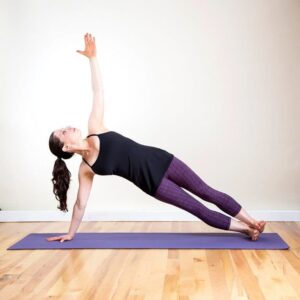
With elbows to knees, a bird dog
The smooth action in this variant on the traditional bird dog engages your abs and back while developing core mobility.
- Begin on all fours, with your hands behind your shoulders and your knees beneath your hips.
- Tighten your abdominal muscles. Raise your right leg to hip level and straighten it. Lift and extend your left arm to shoulder level, palm down, at the same time.
- Bring your right knee and left elbow in close proximity to one another. Return to your original starting position.
- Begin with a single set of 8–12 repetitions.
- Rep on the opposite side.
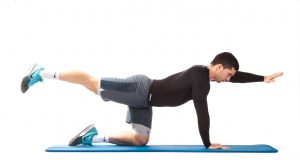
Core-strengthening exercises are a wonderful place to start if you want to start a regular fitness regimen or add a little additional push to one you already have.
Before beginning a new fitness plan, consult with your healthcare provider. Consult a skilled personal trainer if you have a prior or current back problem. They can show you how to tone and exercise your core safely.


